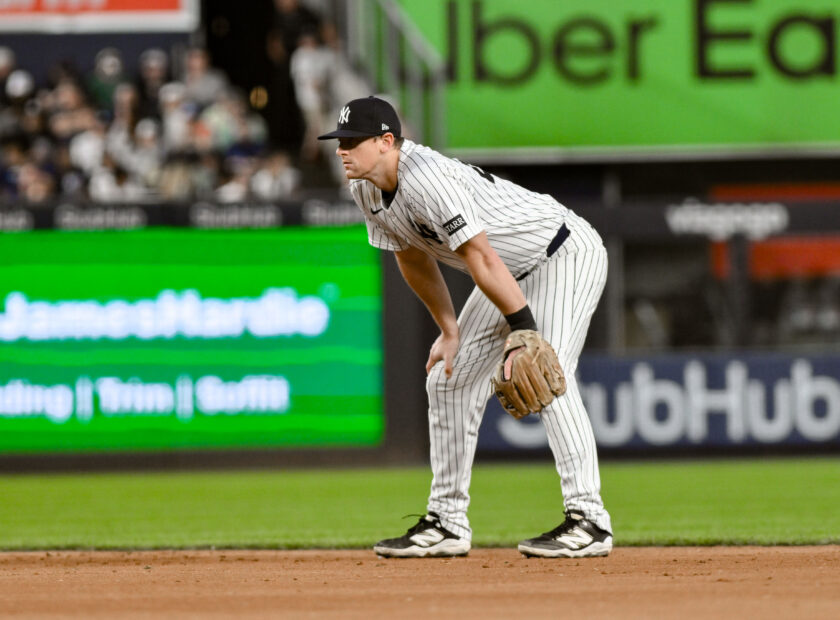New York Yankees: Tanaka Is Returning To Ace Status

The New York Yankees find their starting pitching ranked among the worst in the American League, but Masahiro Tanaka has been a bright spot.
By Christian Kouroupakis
 Yes, it’s true. The New York Yankees starting pitching has been a bona fide mess. Shocker right?
Yes, it’s true. The New York Yankees starting pitching has been a bona fide mess. Shocker right?
Sure the offense is the origin of this current funk, but having a 5.13 ERA from your starters won’t be a benefit, either.
Michael Pineda has struggled mightily to say the least in his first four starts in 2016 as he’s allowed 30 hits in his 22 innings of work and sees his ERA at 6.95.
Nathan Eovaldi is coming off an outing in which he flirted with a no-hitter, but his ERA is still up there at 4.38 and Nasty Nate has surrendered four home runs in his four total starts.
The Yankees’ young phenom Luis Severino, who was expected to take over as the “ace” as soon as this season has done nothing but frustrated fans with his 0-3 record and 6.86 ERA. The 22-year old has surrendered 32 hits in 19.2 innings pitched while seeing his K/9 drop from 8.09 to 5.49.
CC Sabathia has impressed us thus far by turning in two quality starts in his four total, but the one who stands out from this overall insufficient group has been Masahiro Tanaka.
The 27-year-old has witnessed his fair share of issues since the Yankees inked him to a $155-million contract following a 2013 season in which he went 24-0 with a 1.27 ERA for the Rakuten Golden Eagles in Japan.
RELATED: Ortiz’s Go-Ahead Homer Drowns Yankees
In his first go around as a New York Yankee, he resembled the ace they signed him to be as he went 12-4 with a 2.51 ERA with a 9.4 K/9 in the first half of 2014.
Unluckily, he suffered a slight tear in his ulnar collateral ligament and chose against Tommy John Surgery. In fact, a number of orthopedic surgeons urged that he avoid the operation. As a result, it has given his elbow the nickname “ticking time bomb” and everyone is ready for it to detonate at any given moment.
Thankfully, the bomb did not go off throughout the 2015 campaign but he was unable to find himself with a decreased velocity and, in result, he surrendered 25 home runs.
Following the Yankees loss in the American League Wild Card game to the Houston Astros, Tanaka opted to remove a bone spur from the elbow, raising, even more, uncertainty.
Now, after five starts of the 2016 season, Tanaka is looking like the ace that his team needs so very much.
Tanaka is the lone bright spot (1-0, 2.87 ERA) in a rotation that owns an ERA of 4.99. With the exception of last night’s loss in Boston, he has shown he can stop losing streaks, provide the bullpen with length, and get the best of hitters with his not-so-best stuff.
The preceding two starts leading up to game one in Beantown, he has reverted back to how he looked in the first half of the 2014 season as well as being worth every penny of his enormous contract.
Last Sunday against the Seattle Mariners, Tanaka only surrendered two runs in seven innings of work while striking out six against his former Japanese teammate, Hisashi Iwakuma.
Sure he snapped the Yankees’ four-game losing skid, but the most impressive aspect of his start was that he handed the ball over to Dellin Betances and Andrew Miller to secure a win for New York.
Against the Tampa Bay Rays, it was indeed “Tanaka Time” as he dazzled in seven innings while only allowing two runs and striking out six. Repeatedly, he handed the ball over to the back of the pen to give the Yankees a much-needed win having lost seven of their previous nine.
Ask anyone who knows anything about the 2016 New York Yankees, that rubric will turn this team into a powerhouse especially with Aroldis Chapman on the way.
But why has the dominance from his 2014 year returned? One thing is for sure, and never neglect this: Tanaka is a competitor. He will work tirelessly in preparation and execution to get the opposition out.
For starters, Tanaka has parted with his four-seam fastball and relies on his splitter and breaking pitches. So far this year, he has thrown his four-seamer 4.71%, slider 21.84%, sinker 28.05% and his splitter 32.6% of the time according to Brooks Baseball.
He does have a cutter and curveball incorporated in there, but the pitches specified above are the ones he pulls out of his utility belt more often.
Many believed that his increase usage in his split-finger would lead to an increase in BB/9, pitches thrown, and overall, a shrinkage in effectiveness.
Thankfully for Tanaka and the Yankees, his stockpile of pitches has never been more commanding.
His BB/9 rate is at a 1.7 through five starts compared to the 1.4 in 2014 and 1.6 last year, but this year’s number has been dictated by his four-walk performance against a potent Blue Jay lineup. Aside from that outing, he has walked a mere two batters in 26.1 innings pitched.
Another reason for his master status with an exaggerated use of his splitter and sinker is his ability to keep the ball on the ground.
Since the first pitch he threw as an American baseball player, Tanaka has been known as a fly-ball pitcher. As a result, the long ball poses an issue. As brought up earlier, he surrendered 25 home runs in 2015 but here in 2016 he has only let up two.
Entering Friday’s start against the Red Sox, according to Fan Graphs, his ground ball rate is at 56.7% and his fly ball rate is at 23.9%. His career GB% is 47.6 and his career FB% is 31. An obvious result is that Tanaka is giving up the softest contact than he ever has in his brief major league career.
That’s why you see he has given up only those two home runs and the least amount of hits through the first five games of his career.
While the turn-away from his fastball still may lead to an increase in walks, for now, whatever Tanaka is doing, it’s working. The Yankee rotation has been blasphemous, but every fifth day when Tanaka takes the hill, they know they’ll get a man that could be a stopper and more.
NEXT: Subpar April Is No Reason For Panic

Christian Kouroupakis covers the New York Yankees and is the Editorial Director for ESNY. Interact with him and view his daily work by “liking” his facebook page and follow him on Twitter. All statistics are courtesy of Baseball Reference.com unless otherwise noted. Don’t hesitate to shoot him an email with any questions, criticisms, or concerns.






